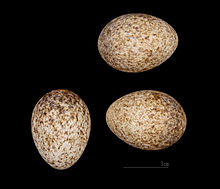African warbler
| African warbler | ||||||||||||
|---|---|---|---|---|---|---|---|---|---|---|---|---|

Spectacled warbler ( Sylvia conspicillata ) |
||||||||||||
| Systematics | ||||||||||||
|
||||||||||||
| Scientific name | ||||||||||||
| Sylvia conspicillata | ||||||||||||
| Temminck , 1820 |
The glasses warbler ( Sylvia conspicillata ) is a singing bird from the genus of Whitethroats ( Sylvia ).
description
The black warbler is very similar to the black warbler . With a body length of 12 to 13 centimeters and a weight of 8 to 10 grams, it is smaller and slimmer. The head of the male is gray with a white throat and black ear covers, the area between the eye and the base of the beak is also black. The eye ring is white. The back is gray-brown, the pink-gray of the chest is darker than that of the black warbler. The wings of both sexes are a single color rust-brown and shorter than that of the black warbler. The female has a brown head than the female warbler.
voice
The call of the spectacled warbler consists of bright, dry humming "drrs", which are often strung into long sequences with short inserted syllables, such as "drrrr-dr-dr-drrrr". The singing is a quick, rapid chirping that often begins with several clear whistling tones and is reminiscent of a crested lark .
distribution and habitat
The small western Palearctic-Mediterranean breeding area in Europe includes Spain , the south of France , central and southern Italy , Sardinia , Corsica , the Balearic Islands , the Cape Verde Islands and the Canaries . To the south of it, the species also colonizes northern Africa from Morocco to the east to Libya . The spectacled warbler is also geographically isolated in a small area in the Middle East ( Cyprus , Syria , Lebanon , Israel and Jordan ). The European populations migrate to northern Africa to overwinter, the southern populations are predominantly resident birds.
The warbler breeds in low bushes on mountain slopes, in scrub and herbaceous vegetation of semi-deserts and salt steppes.
literature
- Einhard Bezzel : Compendium of the birds of Central Europe. Volume 1: Passeres. Songbirds . Aula-Verlag, Wiesbaden 1993, ISBN 3-89104-530-1 .
- Lars Svensson , Killian Mullarney, Dan Zetterström: The Cosmos Bird Guide. All kinds of Europe, North Africa and the Middle East. Franckh-Kosmos Verlag, Stuttgart 2011, ISBN 978-3-440-12384-3 .
Web links
- French website with pictures
- Videos, photos and sound recordings of Sylvia conspicillata in the Internet Bird Collection
- Age and gender characteristics (PDF; 4.1 MB) by Javier Blasco-Zumeta and Gerd-Michael Heinze (English)
- Sylvia conspicillata onthe IUCN 2013 Red List of Threatened Species . Listed by: BirdLife International, 2012. Retrieved January 19, 2014.
- Feathers of the black warbler
